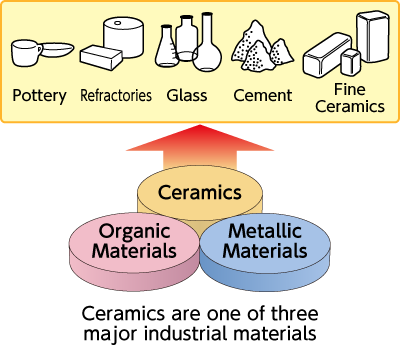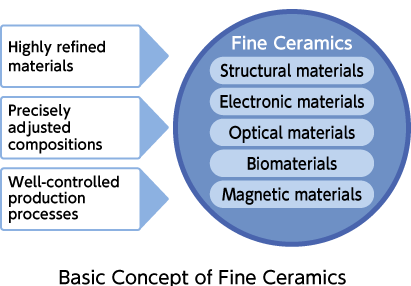"The Big Three" materials comprise metals, organic materials, and ceramics. The English word for ceramics finds its roots in the Greek word "keramos," which translates to "burned clay."
Initially, the term ceramics predominantly referred to china. Non-metallic, inorganic substances such as refractories, glass, and cement are now also referred to as ceramics.
As a result, ceramics are now defined as "non-metallic, inorganic substances that are manufactured through molding or shaping followed by exposure to high temperatures."
Among various ceramics, porcelains are employed in electronics and other high-tech industries that require meticulous specifications and challenging performance requirements.
Today's Fine Ceramics (or "advanced ceramics"), differ from conventional ceramics, which are still crafted from natural substances such as clay and silica rock mined from the Earth.
In contrast, Fine Ceramics are engineered materials with precisely formulated chemical compositions, created from synthesized or highly refined inorganic powders, that undergo a scientifically controlled process of forming and sintering.
In conformity with the International Organization for Standardization (ISO)** 20507 ("Fine ceramics – Vocabulary") and the Japanese Industrial Standards (JIS)*** R 1600, Fine Ceramics are characterized as materials "produced with precisely controlled chemical compositions, microstructures, configurations, and production processes to accomplish predetermined functions, and are composed mainly of non-metallic, inorganic substances."

Image Credit: Kyocera International, Inc.

Image Credit: Kyocera International, Inc.
What are Fine Ceramics?
What are Fine Ceramics?
Video Credit: Kyocera International, Inc.
The Pioneer of Fine Ceramics
The term "Fine Ceramics" gained mainstream usage in the 1970s. Established as Kyoto Ceramic Co., Ltd., Kyocera Corporation has predominantly manufactured Fine Ceramics for the electronics industry since its formation in 1959.
Founder Dr. Kazuo Inamori has consistently affirmed that "unlike conventional ceramics, Fine Ceramics possess significant added value in industrial applications. Their value should not be assessed based on volume; instead, they must be 'fine' in both physical and structural characteristics." Hence, Dr. Kazuo Inamori was the first person to employ the term "Fine Ceramics" to describe a category of new performance materials.

This information has been sourced, reviewed, and adapted from materials provided by Kyocera International, Inc.
For more information on this source, please visit Kyocera International, Inc.